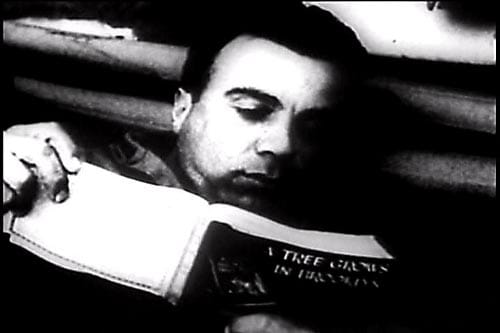
“Soldiering is 99% boredom, 1% sheer terror,” a Civil War soldier wrote to his wife. And since that time, the composition of war has largely remained the same—a whole lot of hurry up and wait.
What to do in those periods between action, especially for the men on the frontlines, those far from any kind of creature comforts or entertainment, has long been a problem. Writing a letter home, playing cards, and shooting the shiz were some of the few available options. But there’s only so many times a man can clean his gun before looking for something else to pass the time.
To combat the morale-sapping effects of boredom during World War II, a unique collaboration between government and private industry launched an effort to distribute almost 1.3 million books to American GI’s. These books, the Armed Services Editions, were eagerly read by men in submarines, battleships, foxholes, and hospital beds, and not only served as a source of entertainment and solace during the war, but also turned many men into lifelong readers when they returned home.
Books for the Fighting Man
At the start of the war, civilians were urged to donate books to the men overseas, but it soon became clear that this effort was ineffective for several reasons. People tended to donate their less desirable titles—things like “Personal Hygiene: The Rules for Right Living”—the way people reach for the corned beef hash during a canned food drive. And even the more appealing books were not well-suited to the mobile GI. Paperback editions had not yet become popular and widespread, and it was impractical for soldiers to be lugging around large, hardcover books.
What was needed were books that were small, compact, and could be carried in a soldier’s cargo pocket. Cheap, lightweight books that could be printed and distributed in mass quantities, read up, and left behind.
The Council on Books in Wartime took up the project of turning this idea into reality. The council, whose motto was “books are weapons in the war of ideas,” was a non-profit organization made up of librarians, authors, booksellers, and publishers which had formed to utilize books as part of the war effort.
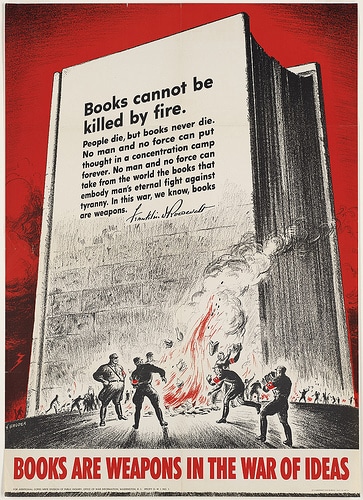
The council started Armed Services Editions Inc. to spearhead the effort to get as many pocket-sized paperback books into the hands of America’s fighting forces as possible. ASE Inc. orchestrated a unlikely collaboration between the military, the government, book publishers, printers, composition firms, and paper suppliers.
How the ASE’s Were Printed
The books had to be small enough to fit in a cargo pocket and cheap enough to enable millions of copies to be printed.
The answer was to use pulp paper and the rotary presses typically employed in printing digest magazines. Since these presses produced digests that were too long to be easily portable, the books were printed “two-up;” two books would be printed together as one, and then sliced in half to make two separate books. Because of this, the books were longer horizontally than vertically, the opposite of a typical paperback.
On average, the books cost 6 cents each to produce and were distributed free to the troops overseas and in veterans’ hospitals on American soil. Publishers agreed to reduce their usual profits and split the one penny royalties between themselves and the authors.
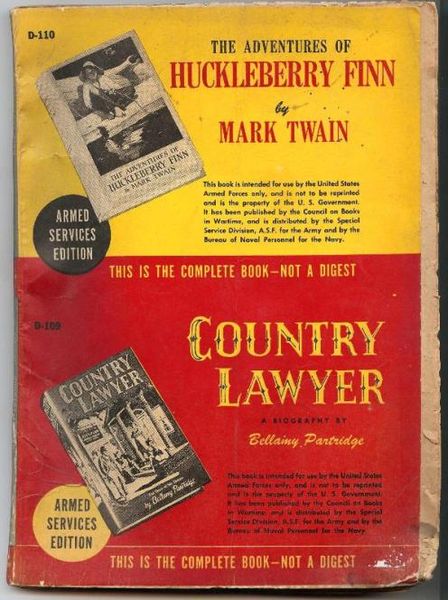
ASE’s were printed “two-up” and then cut apart to make two separate books. This rare copy was preserved uncut. The pages have not been trimmed either. ASE books ranged in size from 5½” to 6½” long and from 3⅞” to 4½” high.
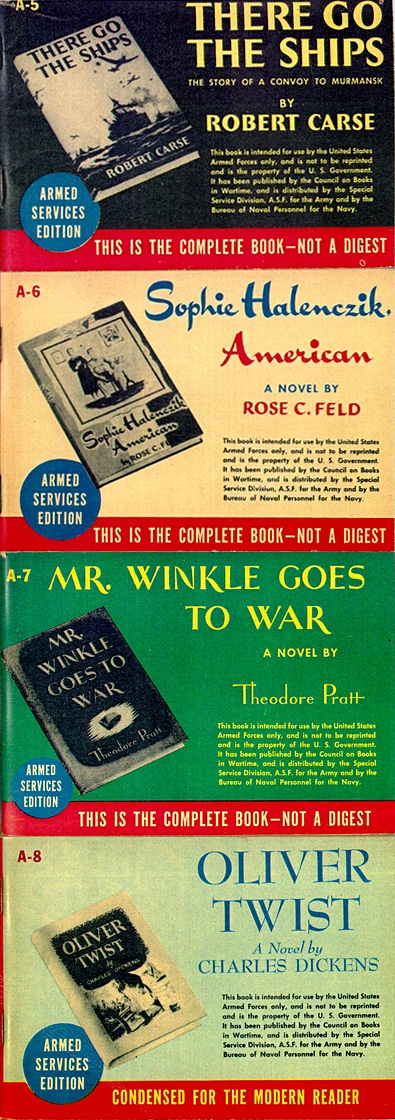
Some presses printed the books “four-up.” Then three cuts were made to make four separate books.

The text of the book was printed in two columns to be easier on the eyes.
Armed Services Editions Titles
1,322 titles were printed during the war. Censorship concerns were rare and the books selected to become ASE’s spanned a wide spectrum from old classics to contemporary bestsellers, from fiction to non-fiction, from collections of short stories to books of poetry. The fiction titles came from every genre: Western, adventure, mystery, fantasy, and more. The non-fiction books covered science, biographies, history, and current events. The council chose both lighter fare with broad appeal and meatier, more serious selections. Only 70 of the 1,322 books had to be abridged for length; the rest were printed in full. Most authors were quite honored to have their book selected to become an ASE, and many received hundreds of letters from soldiers expressing their appreciation.

Several books, both fiction and non-fiction, were printed about the war itself. This one gave a blow by blow of the attack on Pearl Harbor.

The Navy received a quarter of the ASE’s distributed while the Army got the rest. Sailors particularly enjoyed seafaring tales.
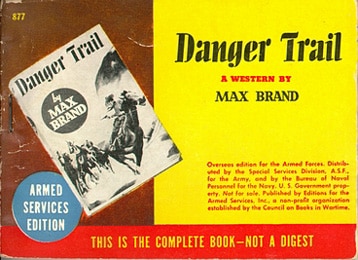
Westerns, mysteries, and adventure stories were the most popular books with the men. Notice the large staple; this reinforced the glue in the binding so the books would stay together even in the rough and tumble of war.

ASE’s ran the gamut from light, comedic stories to serious literature and even Greek philosophy.
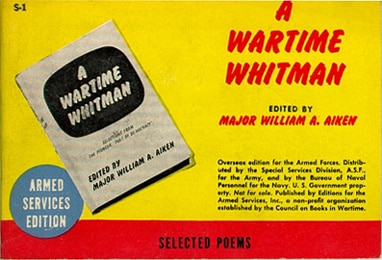
Collections of short stories and poems were popular because they could be read in the snatches of time between assignments. Some of these collections existed only as ASE’s.
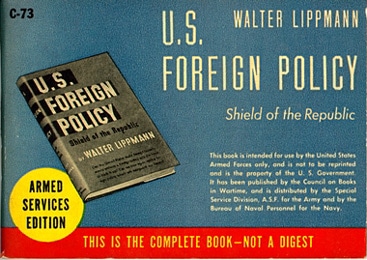
Soldiers had a surprisingly keen interest in understanding more about the context of the war. A 1945 article from the Saturday Evening Post reported, “Observers are divided as to whether the demand overseas for Walter Lippmann’s thoughtful and illuminating U.S. Foreign Policy is merely a reflection of the fact that it was a best-seller here or an indication that soldiers are anxious to know what the hell they’re fighting for and where do we go from here. Maj. Gen Joseph W. Byron, head of the Army Special Services Division, spotted a sergeant engrossed in the Lippmann book in the shade of a bomber in India. The general asked him what he thought of our foreign policy. “I’m not sure yet sir,” he replied. “But I sure would like to know what it’s about, and that’s why I’m reading this.”

The same article referred to the men’s other surprising interest: the workings of the mind.

A useful manual for spotting a fink during friendly card games with one’s comrades!
From 1943 to 1947, almost 1.3 million books were shipped out to the country’s fighting forces. While it was easier to get the books to the men behind the lines, they also found their way into the hands and pockets of soldiers in combat. The biggest distribution of books happened in the lead-up to D-Day. As the troops prepared to storm Normandy, each man was given one book as they boarded the ships headed to the French coast.
The Effect of the Armed Services Editions on the Men

The distribution of ASE’s to America’s GI’s during WWII represents the largest book giveaway in the history of the world. It forever changed the publishing industry by launching the popularity of paperback books when the men returned home. But the effect of the ASE’s on the men themselves was even more significant. The books helped fill the time and keep the men’s minds off their homesickness and fear. Books were eagerly devoured, passed around until they fell into pieces, and even torn in half so two men could read at once. The GI’s were a captive audience, and with little else to do, many of the men found themselves reading a book straight through for the first time in their entire lives.
And they got hooked. Authors of ASE books received letters from soldiers full of gratitude for how much the books had meant to them during lonely nights in the barracks or anxiety filled days in the foxholes. Helen MacInnes, who authored While We Still Live, which was turned into an ASE, remembered one letter particularly well. A former soldier had written to tell her that “he had read little until [the ASE edition] got him enjoying literature. From there, he read constantly, and after his service went to college. He ended with a Ph.D. and sent me a copy. It was dedicated to me, the writer of the novel that started his reading.”
Collecting Armed Services Edition Books
Collecting ASE’s is a popular pastime for those drawn to the unique history of these books. Due to the large number produced, they are easy to find and generally cheap to purchase, often selling from $2-$10. There’s always a bunch on ebay, but a lot of sellers jack up the price; your best bet is to look for them at used book and antique stores.
However, finding some titles can be quite difficult. The books were designed to be “disposable” and used up overseas. And many were, their well-worn pages left behind in fields in Europe and jungles in the Pacific. This is especially true of more popular titles, which were passed around and read until they fell apart.

This novel, the first to be published based on the comic book hero, is the most valuable ASE due to its popular subject and rarity.
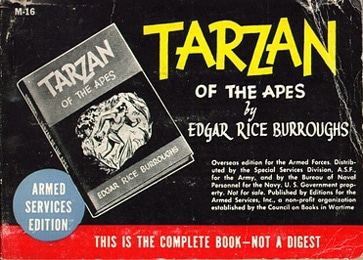
Tarzan books are also valuable as they were so popular that few returned from war.

Sci-fi/fantasy books like Frankenstein, Dracula, and War of the Worlds, are also more valuable because of their appealing subject matter.
Armed Services Editions Today
The production of ASE’s stopped in 1947. Since 2002, Andrew Carroll, author of fantastic books like War Letters, has been trying to revive this invaluable resource for our troops. He started the Legacy Project and got a few publishers on board with distributing new ASE’s to the military. The new ASE’s have the same pocket-sized format and vintage look as the old ones. The project is privately funded and the number of copies printed is very limited. What makes me most happy about this honorable effort? One of the few titles available in the new ASE collection is:
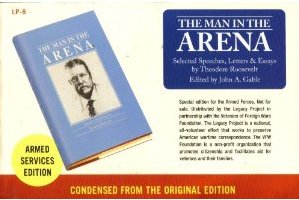 Nice! And it’s even available on Amazon for civilians.
Nice! And it’s even available on Amazon for civilians.
___________________
Sources:
Books Go to War: The Armed Services Editions in World War II
Books in Action: The Armed Services Editions
Tags: Books







